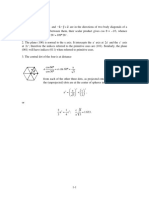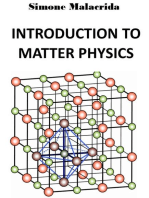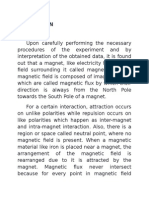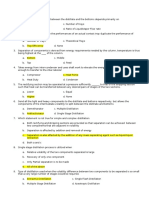PH2302 Homework 3 PDF
Uploaded by
Yeo Jun YiPH2302 Homework 3 PDF
Uploaded by
Yeo Jun YiPH2302: Introduction to Solid State Physics Homework 3: Crystal Binding, Phonon Vibration
Total Marks: 100 Due date: Friday, 25th October 2013 5.30 pm (at your respective tutor office)
1.
(25 marks) One type of antidepressant used in Europe is Rubidium chloride, RbCl. Naturally it has NaCl crystal structure, with equilibrium nearest-neighbour distance . The total lattice energy can be expressed as a function of the nearest-neighbour distance : ( ) [
On this formula, and represent the strength and range of interaction of Pauli repulsion, respectively, is the number of the first nearest neighbour of each ion, while is the Madelung constant. You may assume that the Pauli repulsion only exist between nearest neighbours. In this problem, express all energies in unit. a. b. (5 marks) Estimate the cohesive energy of RbCl crystal using the information given above. (15 marks) Assuming that the Pauli repulsion parameters are constant, estimate the equilibrium nearest-neighbour distance and cohesive energy of RbCl if, hypothetically, it exists in ZnS structure. Madelung constant of ZnS structure is . (5 marks) Compare the cohesive energies of RbCl in NaCl and ZnS structure. Hence or otherwise, argue that the one with ZnS structure is not naturally favoured.
c.
2.
(10 marks) NaCl ( ), NaBr ( ) and KCl ( ) all have the same structure, which is the NaCl structure. Assuming the spacings are determined by the ionic radii of the relevant ions, what value would you expect for the lattice constant of KBr? (15 marks) Consider an incoming neutron of wavelength moving towards a crystal. Its found that the scattered neutron has 20% less energy compared to the incoming neutron. a. b. c. (5 marks) Calculate the wavelength of the scattered neutron. (5 marks) Calculate the frequency of the phonon, , created in the crystal. (5 marks) Assume that the direction of the phonon is on the same line as the direction of the incoming neutron. Calculate the momentum of the phonon created.
3.
4.
(50 marks) Consider a one-dimensional lattice with a basis of two ions of identical mass M. Their interaction is modelled by masses connected by alternating two different springs of spring constant and respectively. Neighbouring ions connected by different spring may have different separation, but distance between an ion and its second neighbour is always . A simple diagram is shown below.
( ( a.
) )
( (
) )
(20 marks) By using a similar approach as given in lecture notes (construct the equation of motions for two consecutive ions), derive the dispersion relations. Show that: | | | |
b. c. d.
)( ) Hint: | | ( (10 marks) Sketch the dispersion relations, vs. , for the first Brillouin zone, and write down the value of at the zone boundaries and the maximum point. (10 marks) Find the dispersion relations for small . (10 marks) If and , where , show that for the dispersion relation reduces to monoatomic linear chain of separation .
Hint: Reading on Ashcroft/Mermins Solid State Physics page 433-437 may be helpful. Ps: This problem can be quite long and tedious.
You might also like
- (Solutions) Kittel - Introduction To Solid State Physics 8Th Edition0% (1)(Solutions) Kittel - Introduction To Solid State Physics 8Th Edition60 pages
- 《固体物理导论》 习题解答.charles Kittel.2004年第8版.introduction to Solid State Physics Solution ManualNo ratings yet《固体物理导论》 习题解答.charles Kittel.2004年第8版.introduction to Solid State Physics Solution Manual61 pages
- Physics 725: Solid State Physics I: In-Class Midterm ExamNo ratings yetPhysics 725: Solid State Physics I: In-Class Midterm Exam14 pages
- Physics 725: Assignment 1: (To Be Submitted by Tuesday, September 20, 2016)No ratings yetPhysics 725: Assignment 1: (To Be Submitted by Tuesday, September 20, 2016)3 pages
- Kittel Charles - Introduction To Solid State Physics 8Th Edition - Solution Manual86% (35)Kittel Charles - Introduction To Solid State Physics 8Th Edition - Solution Manual60 pages
- Draft of Solution: EXAM IN COURSE TFY4220 Solid State PhysicsNo ratings yetDraft of Solution: EXAM IN COURSE TFY4220 Solid State Physics8 pages
- FoP2B CMP Revision Lecture1 2023 CourseSummaryNo ratings yetFoP2B CMP Revision Lecture1 2023 CourseSummary5 pages
- Microelectronics II: EE 311A, January-May 2021No ratings yetMicroelectronics II: EE 311A, January-May 20212 pages
- 2.57 Nano-to-Macro Transport Processes Fall 2004: A Wigner-Seitz Primitive Unit CellNo ratings yet2.57 Nano-to-Macro Transport Processes Fall 2004: A Wigner-Seitz Primitive Unit Cell6 pages
- Assignment - 2 - Crystallography II - SolutionsNo ratings yetAssignment - 2 - Crystallography II - Solutions6 pages
- Mcqs Solid State Physics (Chapter 3-5) by Mansoor SultanNo ratings yetMcqs Solid State Physics (Chapter 3-5) by Mansoor Sultan7 pages
- CGPDTM 2023 - Mains Physics - Mock-7 - Solid State PhysicsNo ratings yetCGPDTM 2023 - Mains Physics - Mock-7 - Solid State Physics7 pages
- Reciprocal Lattice Continuous Lattice Laue ZoneNo ratings yetReciprocal Lattice Continuous Lattice Laue Zone13 pages
- Introducción A La Física de Estado Sólido - Charles Kittel - 8va Edición PDFNo ratings yetIntroducción A La Física de Estado Sólido - Charles Kittel - 8va Edición PDF60 pages
- PHYS-30021J-ElectronsInCrystals-Exam-2012-2013-Jan-final 2No ratings yetPHYS-30021J-ElectronsInCrystals-Exam-2012-2013-Jan-final 25 pages
- Negative Mass and Negative Refractive Index in Atom Nuclei - Nuclear Wave Equation - Gravitational and Inertial Control: Part 2: Gravitational and Inertial Control, #2From EverandNegative Mass and Negative Refractive Index in Atom Nuclei - Nuclear Wave Equation - Gravitational and Inertial Control: Part 2: Gravitational and Inertial Control, #2No ratings yet
- Negative Mass and Negative Refractive Index in Atom Nuclei - Nuclear Wave Equation - Gravitational and Inertial Control: Part 5: Gravitational and Inertial Control, #5From EverandNegative Mass and Negative Refractive Index in Atom Nuclei - Nuclear Wave Equation - Gravitational and Inertial Control: Part 5: Gravitational and Inertial Control, #5No ratings yet
- Electron Beam-Specimen Interactions and Simulation Methods in MicroscopyFrom EverandElectron Beam-Specimen Interactions and Simulation Methods in MicroscopyNo ratings yet
- Problems in Quantum Mechanics: Third EditionFrom EverandProblems in Quantum Mechanics: Third EditionD. ter Haar3/5 (2)
- Intensity of Electromagnetic Waves as a Function of Frequency, Source Distance and Aperture AngleFrom EverandIntensity of Electromagnetic Waves as a Function of Frequency, Source Distance and Aperture AngleNo ratings yet
- Negative Mass and Negative Refractive Index in Atom Nuclei - Nuclear Wave Equation - Gravitational and Inertial Control: Part 3: Gravitational and Inertial Control, #3From EverandNegative Mass and Negative Refractive Index in Atom Nuclei - Nuclear Wave Equation - Gravitational and Inertial Control: Part 3: Gravitational and Inertial Control, #3No ratings yet
- X-ray Absorption Spectroscopy for the Chemical and Materials SciencesFrom EverandX-ray Absorption Spectroscopy for the Chemical and Materials SciencesNo ratings yet
- On the quantum theory of radiation and the structure of the atomFrom EverandOn the quantum theory of radiation and the structure of the atomNo ratings yet
- Negative Mass and Negative Refractive Index in Atom Nuclei - Nuclear Wave Equation - Gravitational and Inertial Control: Part 4: Gravitational and Inertial Control, #4From EverandNegative Mass and Negative Refractive Index in Atom Nuclei - Nuclear Wave Equation - Gravitational and Inertial Control: Part 4: Gravitational and Inertial Control, #4No ratings yet
- Think Physics: Beginner's Guide to an Amazingly Wide Range of Fundamental Physics Related QuestionsFrom EverandThink Physics: Beginner's Guide to an Amazingly Wide Range of Fundamental Physics Related QuestionsNo ratings yet
- Negative Mass and Negative Refractive Index in Atom Nuclei - Nuclear Wave Equation - Gravitational and Inertial Control: Part 1: Gravitational and Inertial Control, #1From EverandNegative Mass and Negative Refractive Index in Atom Nuclei - Nuclear Wave Equation - Gravitational and Inertial Control: Part 1: Gravitational and Inertial Control, #1No ratings yet
- Unified Field Theory in a Nutshell1: The Quest for the Theory of EverythingFrom EverandUnified Field Theory in a Nutshell1: The Quest for the Theory of EverythingNo ratings yet
- Principles and Practices of Molecular Properties: Theory, Modeling, and SimulationsFrom EverandPrinciples and Practices of Molecular Properties: Theory, Modeling, and SimulationsNo ratings yet
- Mathematical Foundation of the Quantum Theory of Gravity: Beyond Einstein, #3From EverandMathematical Foundation of the Quantum Theory of Gravity: Beyond Einstein, #31/5 (1)
- MC 2009 - 3 Documents To Be Submitted in Lieu of The Required Certificate of Finality Involving Court Decrees-Decision-OrdersNo ratings yetMC 2009 - 3 Documents To Be Submitted in Lieu of The Required Certificate of Finality Involving Court Decrees-Decision-Orders4 pages
- Croda Eseminar Coatings Polymers Mar 312010100% (1)Croda Eseminar Coatings Polymers Mar 31201032 pages
- Experiment - 7: Aim: Sizing of Pressure VesselNo ratings yetExperiment - 7: Aim: Sizing of Pressure Vessel5 pages
- Terahertz Technology 3rd Edition Xander Phillips all chapter instant download100% (2)Terahertz Technology 3rd Edition Xander Phillips all chapter instant download77 pages
- Quantum theory of solids 1st Edition Eoin O'Reilly All Chapters Instant Download100% (6)Quantum theory of solids 1st Edition Eoin O'Reilly All Chapters Instant Download50 pages
- 9702 Grade Booster-AS-Frequently Examined Questions FEQsNo ratings yet9702 Grade Booster-AS-Frequently Examined Questions FEQs20 pages
- Exercises Iv:Atomic Absorbtion Spectroscopy (Aas)No ratings yetExercises Iv:Atomic Absorbtion Spectroscopy (Aas)17 pages
- Prospectus of Use of Graphene in Military TechnologyNo ratings yetProspectus of Use of Graphene in Military Technology8 pages
- Vibration Damping Techniques in Wind Turbine BladesNo ratings yetVibration Damping Techniques in Wind Turbine Blades16 pages
- 120 TOP MOST SINGLE PHASE INDUCTION MOTORS - Electrical Engineering Multiple Choice Questions and AnswersNo ratings yet120 TOP MOST SINGLE PHASE INDUCTION MOTORS - Electrical Engineering Multiple Choice Questions and Answers11 pages
- Class 12 Physics Notes Chapter 3&4 Studyguide360No ratings yetClass 12 Physics Notes Chapter 3&4 Studyguide36046 pages
- Gravity Separation-Old Technique-New Methods PDFNo ratings yetGravity Separation-Old Technique-New Methods PDF19 pages
- Physics 30 Unit 2: Worksheet 1: Movement of Charges & Coulomb's Law BasicsNo ratings yetPhysics 30 Unit 2: Worksheet 1: Movement of Charges & Coulomb's Law Basics23 pages

























































































